The Core i7 980X Review: Intel's First 6-Core Desktop CPU
by Anand Lal Shimpi on March 11, 2010 12:00 AM EST- Posted in
- CPUs
It’s rare that anything we review has the longevity that Intel’s Core i7 Bloomfield platform has enjoyed. If you were one of the fortunate few to buy a Core i7 920, 940 or 965 back in November 2008, you’d still have one of the fastest desktop CPUs today in March 2010.
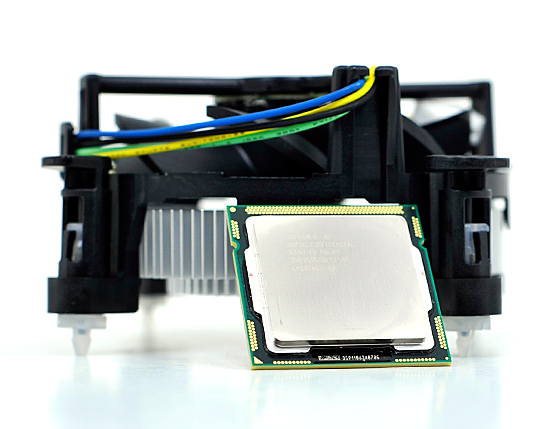
Lynnfield was introduced in 2009, but still couldn't dethrone Bloomfield.
In fact, other than a few minor speed bumps, Intel hasn’t done much with its LGA-1366 platform in the past 15 months. Last year Intel introduced Nehalem for the rest of us with its LGA-1156 socket and in January we got the first dual-core derivatives.
Now it’s finally time to take care of the folks who invested in Nehalem and Core i7 early on. In the coming weeks Intel will be shipping its first 6-core desktop processor, built using the same 32nm process used in the Clarkdale Core i3/i5 CPUs. It’s codenamed Gulftown but today we can call it the Core i7 980X. Did I mention that with a BIOS update it’s fully compatible with all X58 motherboards? That’s right, even if you bought a board in November 2008 - you can upgrade directly to Gulftown.
| Processor | Core Clock | Cores / Threads | L3 Cache | Max Turbo | TDP | Price |
| Intel Core i7 980X | 3.33GHz | 6 / 12 | 12MB | 3.60GHz | 130W | $999 |
| Intel Core i7 975 | 3.33GHz | 4 / 8 | 8MB | 3.60GHz | 130W | $999 |
| Intel Core i7 960 | 3.20GHz | 4 / 8 | 8MB | 3.46GHz | 130W | $562 |
| Intel Core i7 930 | 2.80GHz | 4 / 8 | 8MB | 3.06GHz | 130W | $284 |
| Intel Core i7 870 | 2.93GHz | 4 / 8 | 8MB | 3.60GHz | 95W | $562 |
| Intel Core i7 860 | 2.80GHz | 4 / 8 | 8MB | 3.46GHz | 95W | $284 |
| Intel Core i5 750 | 2.66GHz | 4 / 4 | 8MB | 3.20GHz | 95W | $196 |
| Intel Core i5 670 | 3.46GHz | 2 / 4 | 4MB | 3.73GHz | 73W | $284 |
| Intel Core i5 661 | 3.33GHz | 2 / 4 | 4MB | 3.60GHz | 87W | $196 |
| Intel Core i5 660 | 3.33GHz | 2 / 4 | 4MB | 3.60GHz | 73W | $196 |
| Intel Core i5 650 | 3.20GHz | 2 / 4 | 4MB | 3.46GHz | 73W | $176 |
| Intel Core i3 540 | 3.06GHz | 2 / 4 | 4MB | N/A | 73W | $133 |
| Intel Core i3 530 | 2.93GHz | 2 / 4 | 4MB | N/A | 73W | $113 |
| Intel Pentium G9650 | 2.80GHz | 2 / 2 | 3MB | N/A | 73W | $87 |
The Entire 2010 Nehalem/Westmere lineup
In fact, that’s exactly what I did for today’s review. This is Intel’s DX58SO motherboard I used in my original Core i7 review in November 2008:
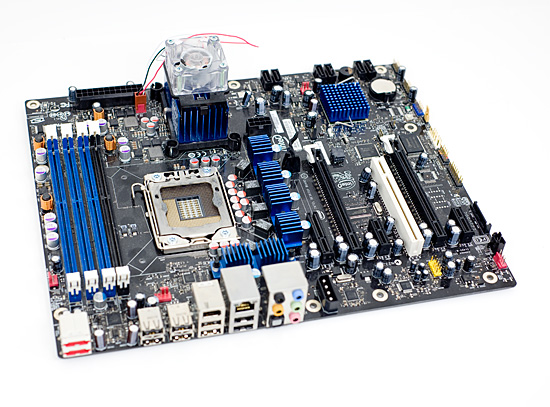
It’s the same exact board, but updated to the 5020 BIOS that’s currently available on Intel’s site. Intel was sneaky and actually enabled Gulftown support in its motherboards a few weeks ago.
And here we have the result:
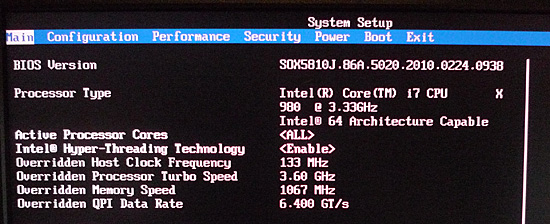
Intel’s Core i7 980X, running at 3.33GHz with 6 cores, 12 threads and a massive 12MB L3 cache all running on a motherboard that shipped a year and a half ago.

The old board works mostly fine with the 980X but with some odd bugs and quirks that I ran into. I found that my older DDR3-1066 memory wouldn't overclock to 1333MHz with Gulftown, although it did just fine with Bloomfield for some reason.
It’s not just Intel enabling support either. All motherboard manufacturers either have or are expected to have BIOSes with Gulftown support by the time this chip ships in the coming weeks. ASRock sent over its X58 Extreme, which worked perfectly with the new chip:
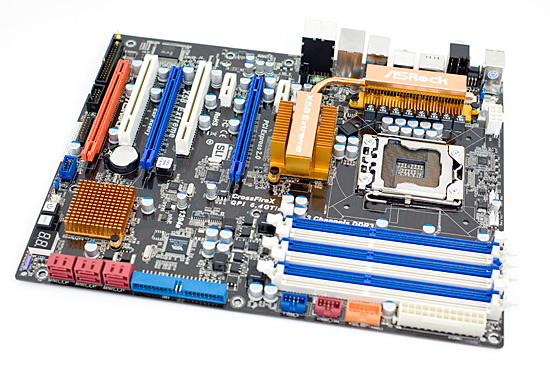
It’s Extreme
The coolest part of Gulftown is that by building it on Intel’s 32nm process it’s actually smaller than both Bloomfield and Lynnfield, despite having 50% more cores and L3 cache:
| CPU | Codename | Manufacturing Process | Cores | Transistor Count | Die Size |
| Westmere 6C | Gulftown | 32nm | 6 | 1.17B | 240mm2 |
| Nehalem 4C | Bloomfield | 45nm | 4 | 731M | 263mm2 |
| Nehalem 4C | Lynnfield | 45nm | 4 | 774M | 296mm2 |
| Westmere 2C | Clarkdale | 32nm | 2 | 384M | 81mm2 |
| AMD Phenom II X4 | Deneb | 45nm | 4 | 758M | 258mm2 |
At 1.17 billion transistors, it’s a beefy chip but the monolithic die only measures 240mm^2. It’s even smaller than an AMD Phenom II X4. Not only does it have a smaller die than all quad-core Nehalem processors, but it also has the same TDP.
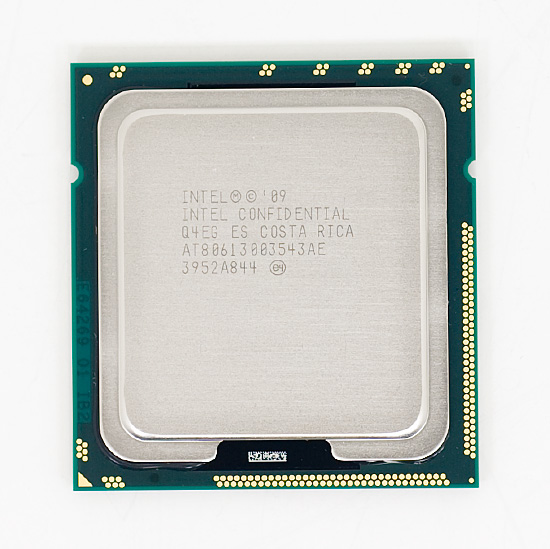
The 130W chip runs at 3.33GHz, but because of the high TDP it can only turbo up to 3.46GHz with more than two cores active. If only one or two cores are active, the chip can turbo up to 3.60GHz. With up to 6 cores running at 3.46GHz, Gulftown is not only the fastest CPU in Intel’s lineup, it’s also the fastest quad-core Intel makes. Only the Core i5 670 can run at a higher frequency with a single core active (3.73GHz vs 3.60GHz).
The downside to all of this is the price tag. The Core i7 980X is an Extreme Edition processor, meaning it’s introduced at the $999 price point. And currently it’s the only way to get 6-cores in a Core i7. Currently Intel doesn't have any plans to introduce 4-core versions of Gulftown on the desktop, although we will see some 32nm quad-core Xeons later this year.
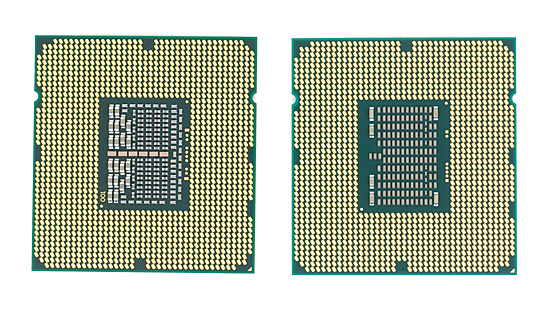
Bloomfield (left) vs. Gulftown (right)
This isn’t the first time that the $999 price tag comes with some exclusive features. The first Pentium 4 Extreme Edition was the very first to wear the EE brand. While all regular Pentium 4s at the time had a 512KB L2, the Pentium 4 Extreme Edition added a 2MB L3 cache - a feature that never trickled down to the mainstream P4s.
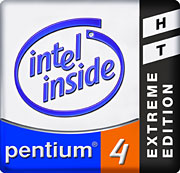
Since then, most Extreme Edition parts have just been higher clocked CPUs. Despite that, they do sell well enough for Intel to continue the practice. Given that this time around, the Core i7 980X will not only give you clock speed but more cores and cache, Intel will probably end up selling more of these than they ever have.










102 Comments
View All Comments
Anand Lal Shimpi - Thursday, March 11, 2010 - link
That depends on the board I believe. Intel's DX58SO may not post without the BIOS update.Take care,
Anand
Jammrock - Thursday, March 11, 2010 - link
One small title error. Intel's Xeon X7000-series CPUs are the first hex-core processors from Intel. Those are server only, but they are out there.http://ark.intel.com/Product.aspx?id=36947&cod...">http://ark.intel.com/Product.aspx?id=36...16M+Cach...
Gulftown is the first desktop hex-core though.
Anand Lal Shimpi - Thursday, March 11, 2010 - link
Corrected :)Take care,
Anand
artifex - Thursday, March 11, 2010 - link
3x cores and threads for less than 2x the TDP of their dual cores? sexy!Isaac the k - Thursday, March 11, 2010 - link
I must say, I do find this rather exciting.But since I'm running a poorly threaded data-simulation app with extremely high throughput, I'm debating whether the extra latency vs. the larger shared cache could potentially harm performance.
If it wouldn't, I might actually request one for what my office is doing right now...
mikeblas - Thursday, March 11, 2010 - link
Aren't the Xeon E7450, Xeon L7455, and Xeon X7460 all six-core Intel processors that were released before this processor?semo - Thursday, March 11, 2010 - link
If I understand this right Nahalem is the name of the micro architecture and not any CPU in particular. On page 2, the first die shot is captioned Nehalem. Shouldn't it be Bloomfield?BTW Anand, you are doing a good job demystifying desktop products but the mobile space is even worse
arandale http://ark.intel.com/ProductCollection.aspx?codeNa...">http://ark.intel.com/ProductCollection.aspx?codeNa... vs clarkdale http://ark.intel.com/ProductCollection.aspx?codeNa...">http://ark.intel.com/ProductCollection.aspx?codeNa...
vPro is even more confusing. E.g. AMT KVM is supposed to work on AMT 6.0 + on chip GPU yet the i3 don't apply... or the i5-661 http://communities.intel.com/community/openportit/...">http://communities.intel.com/community/...ote-cont...
it would be useful if we could get some articles on mobile chips and/or vPro
iwodo - Thursday, March 11, 2010 - link
Waiting for Sandy Bridge- which will hopefully be the true successor of Core 2 Duo.PCI - Express 3.0, SATA 3.0, USB 3.0 ( Light Peak will be even better ), Bluetooth 4.0.
AnnonymousCoward - Saturday, March 13, 2010 - link
Light Peak is kinda dumb...I think that's just multi-lane USB3/PCIe, and using light instead of wires is pointless since no one needs really long point-to-point cables. Apple just wants it since they're all about marketing new flashy things. USB3 could just as easily use as many lanes as you want, but it'd be unnecessarily expensive since 1 lane at 5Gbps is much faster than anything.Pessimism - Thursday, March 11, 2010 - link
This is not intel's first 6 core CPU. The 6 core Xeon 7400 was announced in 2008.